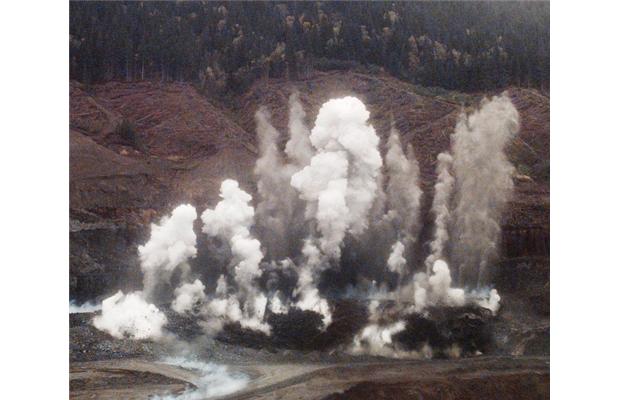OTTAWA — A threat by a B.C. First Nation to shut down a B.C. mine is a small sign of a potentially “catastrophic” uprising in Canada if Aboriginal Peoples don’t become full participants in natural resource extraction, a prominent think-tank warned Wednesday.
On Tuesday, the Wet’suwe’ten First Nation threatened to shut down the $455-million expansion of the Huckleberry Mines Ltd. copper/molybdenum operation, 123 kilometres southwest of Houston, in northern B.C.
Wet’suwet’en Chief Karen Ogen said Wednesday the mine’s access road and power transmission line crosses her band’s reserve near Owen Lake.
She said the Wet’suwet’en would likely start by charging a toll on mine workers and contractors using the road. But if the band’s demand for jobs for its members are not met, she threatened more drastic action.
“If we have to the hydro lines will come down,” she vowed.
The warning of possible violence across Canada comes from Douglas Bland, a professor emeritus at Queen’s University in Kingston. Bland, in one of two reports on resource development and First Nations published by the Macdonald-Laurier Institute, argued Canadians should take heed of the Idle No More movement that held protests across Canada against federal inaction on key issues.
“An idea that most Canadians would have seen as preposterous a year ago … is now very real,” he wrote. “The possibility of a catastrophic confrontation between Canada’s settler and aboriginal communities, spurred not by yesterday’s grievances but by the central features and consequences of our national policies, have the potential to make such an uprising feasible, if not … inevitable.”
Ogen said none of the 230 full-time and 30 contract positions at the Huckleberry mine nor any of the 70 jobs to be created by the expansion go to members of her community, despite numerous meetings with the company.
“The Wet’suwet’en chief and council were instructed by their members to take whatever action is necessary, including direct action and legal action, to stop further mine expansion,” a news release stated.
Huckleberry Mines Ltd. is 50-50 joint venture of Vancouver-based Imperial Metals Ltd. and a consortium of Japanese firms. Huckleberry vice-president Randall Thompson said if the access road were blocked, the mine would likely have to shut down.
Huckleberry vice-president Randall Thompson said 15 to 18 per cent of the mine’s workforce are aboriginal, but are primarily members of first nations communities nearer the mine. However, he said, one recent contract involved Wet’suwet’en members.
He said company talks broke down after the Wet’suwet’en demanded “first right of refusal” on all future contracts.
“The problem is, we have five First Nations we have to deal with,” Thompson said.
Brian Lee Crowley, executive-director of the Macdonald-Laurier Institute, said the threatened blockade in B.C. is a wake-up call for Canadians.
“We think there are lots of examples of rail and road blockades, for example, that are potentially forerunners of much larger conflict if we do not get our act together,” he said in an interview Wednesday.

Bland, a retired lieutenant-colonel and author of a 2009 book about a fictional armed aboriginal insurgency in Canada, wrote that determined young “warriors” could cause huge economic damage by targeting pipelines, ports and key arteries.
“Unfortunately for Canada, the interwoven economic/national resources/transportation matrix is irreversibly vulnerable, as it presents targets that cannot be fully protected.”
In B.C., Bland suggested, ports, oil and gas pipelines, pumping stations, refineries and BC Hydro facilities are potential targets.
Bland argued that a revolt, either “armed or unarmed,” could be far more organized and national in scope than the sporadic and localized acts of violent resistance such as the armed standoff at Oka, Que., in 1990, the confrontation at Gustafsen Lake in B.C. in 1995, a clash between non-native lobster fishermen and the Burnt Church First Nation in New Brunswick in 1999, and the land dispute involving the Six Nations Confederacy in Caledonia, Ont., in 2006.
Assembly of First Nations National Chief Shawn Atleo welcomed as “timely” the two reports, but chose to focus on the second paper that stressed the need for First Nations to get better access to training, jobs and profit-sharing arrangements.
“I certainly welcome these reflections, it really helps put some focus and intention on the requirement for some bold and transformative action,” Atleo said in an interview.
“We should be learning from what happened in Oka, learning from what happened in Burnt Church, in Gustafsen Lake, in Caledonia.”
Despite the tension this week at the Huckleberry mine, the think-tank’s authors portrayed B.C. as a model for the country because of Victoria’s efforts to ensure that first nations share in forestry and mining revenues.
But if more significant progress isn’t made, Bland argued, key infrastructure from coast to coast is vulnerable.
Vulnerable to protests — Potential targets across the country:
Alberta: Oil and gas pipelines, pumping stations, refineries, and coal-carrying railway systems.
Saskatchewan: Pipelines, railways, and key Trans-Canada Highway intersections.
Manitoba: Any road and railway intersections would be vulnerable in Canada’s historic transportation hub, as well as hydroelectric facilities, transmission lines, and the pipeline that supplies Winnipeg’s entire fresh water supply.
Ontario: The province’s major highways, including roads and bridges to the U.S.
Quebec: Hydro-Quebec power generating facilities and transmission lines, bridges near Montreal and Quebec City, highways along the St. Lawrence River, and highways to the U.S. border.
Atlantic Canada: Road and railway approaches to key ports as well as hydroelectric transmission lines from Quebec.
(Source: Macdonald-Laurier Institute)
- Freeland set to table 2024 federal budget in the House of Commons
- Tired of after-hours emails? Budget 2024 plans ‘right to disconnect’
- Budget 2024: Liberals look to offset drug plan cost with higher smoking, vaping taxes
- Budget 2024 commits $5B for Indigenous loan guarantees, but falls short on infrastructure

Comments